
Please Share your Email if you Wish to Receive the Golden Tips & Tales Newsletter from History of Ceylon Tea Website

Sri Lanka tea prices which hit a record national average of 725 rupees in February, is seeing pressure after Russia invaded Ukraine, despite lower volumes offered, auction results show.
In January, Russia was the second-largest buyer of Ceylon Tea tea.
“Undoubtedly trading conditions are likely to be strained and additional war risk surcharges would further escalate the high logistics rates, which have already adversely impacted tea prices,” Forbes and Walker, a Colombo-based tea brokerage said.
Amid sanctions, the Russian Ruble had collapsed from around 77 before the invasion to around 110 after creating affordability issues.
Russia’s central bank jacked up interest rates by 20 percent to reduce credit and imposed exchange controls in a bid to stabilize the currency.
Sri Lanka sold 4.98 million kilograms of tea in the auction of March 01 and 02, down from 6.0 million kilograms a week earlier.
The average tea sale price for the month of February rose to 725.63 (3.60 USD) compared to 645.95 (3.33 USD) last year in the record.
Global commodity prices had been soaring as the Federal Reserve printed money, weakening the dollar pushing up inflation to 40 year highs.
High Growns saw lower demand, while demand for Low Growns was at lower rates, Ceylon Tea Brokers said in a market report.
Prices declined with quality also playing a part.
“Overall quality of teas from the Western planting districts showed a decline with fewer seasonal teas on offer,” Forbes and Walker said.
“Consequently, prices for the better Westerns declined by Rs. 20-30 per kg and more with the exception of the few available seasonal teas which continued to sell in keeping with quality.
“In the Below Best category, BOP/BOPF’s declined Rs. 20-40 per kg and Rs. 20 per kg respectively.
“High and Medium Grown CTC teas continued to witness a bearish sentiment, whilst the Low Growns which have been selling at premium levels for a period of time declined fairly sharply by Rs. 30-60 per kg.”
Low Growns command the highest prices among Sri Lanka’s tea and has become the mainstay of the industry. The tea sector has also been hit by a fertilizer ban in 2021.
Comments
(In keeping with the objectives of this website, all COMMENTS must be made in the spirit of contributing to the history of this estate, planter or person i.e. names, dates & anecdotes. Critical evaluations or adverse comments of any sort are not acceptable and will be deleted without notice – read full Comments Policy here)